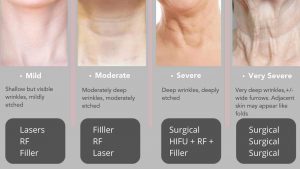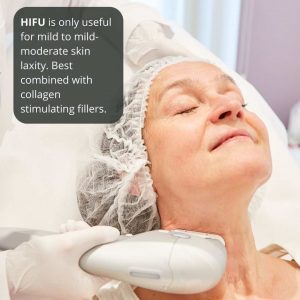Skin tightening, At A Glance
- Best Results2-6 sessions
- Treatment Recovery0-9 days
- Procedure Time20-60 min
- Skin SpecialistMy team & I
- Duration of ResultsVariable; years+
- AnaestheticVariable
- Back to WorkVariable
- Cost$-$$$$$
Skin Tightening
Effective skin tightening is one of the most highly complex procedures as there are many facets to consider including clinical findings, goals, ethnicity, age & budget. The best non-surgical outcomes are achieved when multiple layers of the skin are treated. My team & I employ collagens stimulating dermal fillers, high intensity ultrasound, radiofrequency (multiple devices), threads, lasers & chemical peels to tighten, firm & lift sagging skin.
FactsFacts on Skin Tightening
- We have effective methods to treat mild to moderate skin laxity
- The approach considers ethnicity, background sun exposure, thickness of skin layers, budges & goals
- Radiofrequency devices can tighten & firm with no downtime
- HIFU-ultrasound is best used for lower face skin laxity
- Threads are best combined with other tightening procedures
- New biostimulatory dermal fillers can treat laxity on the face & neck
- Lasers are indicated if laxity is associated with compromised skin quality
How to approach skin tightening (to get an effective result)?
Approach skin tightening from the end point; namely clinical features. Then come up with a road map to get to the destination. Everyone is different, tailor bespoke treatments. Don’t approach it from a cookie cutter treatment/s point of view. Spend a few minutes reading this page to understand more about the complexities of non-surgical skin tightening. It will save you a lot of time, effort & heaps of $$$.
What are ways to tighten skin?
There are many devices that have the potential to tighten skin. They include simple, low-cost DIY- home microcurrent devices (more on that at the end of this page), to powerful lasers, deep chemical peels, radiofrequency devices, HIFU as well as new biostimulatory hybrid dermal filler.
The ideal treatment/s is a combination of these methods, based upon your clinical findings.
Here is a list of what my team & I utilize to tighten skin-
Lasers
CO2, erbium, hybrid lasers, fractional, pico
Best for: poor skin quality & laxity
Radiofrequency devices
Tempsure, Pelleve, NuEra, Genius, Infini RF
Best for: Thin skin, minimal photodamage, combination therapy
TCA, Jessner
Best for: Sun damage skin with poor skin quality & mild to moderate laxity
Threads
PDO, screw, monofilament, cog
Best for: combination treatments
Ultrasound devices
HIFU, Ultherapy, Ultraformer
Best for: lower face laxity with thick dermis & or fat layer. Mild to moderate laxity
Soft tissue fillers
Hybrid fillers, calcium hydroxyapatite, Polymer Injectable
Best for: mild to moderate laxity, face & neck.
Home devices
Microcurrent, home laser devices
Best for: Maintaining skin turgor & quality
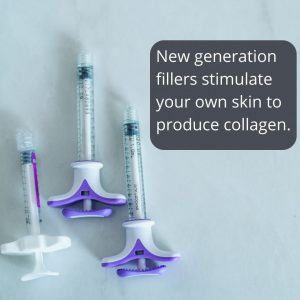
What types of lasers can stimulate collagen & tighten skin?
The two main types of lasers include CO2 & erbium lasers. These lasers tighten skin by stimulating new collagen. The upside of lasers is that they give a predictable result. By stripping away decades of wrinkled & laxed skin, lasers can provide an improvement in skin laxity with only one treatment.

The downside of laser resurfacing is the prolonged downtime of over one week. To help reduce recovery time, we may perform fractional laser resurfacing. This treatment can give close to 80% of the results of deeper lasers, without the long downtime, costs & risks of traditional deep resurfacing.
What types of thread lifts are there & do they work?
The three main types of threads are barbed (suspension, anchoring-cogged), smooth PDO monofilament, & screw threads. I have been using threads for just over 12 years & will give you my take on these three groups, including why I prefer PDO monos.
Suspension-anchoring-cog threads
- Gives brilliant before & after photos
- More predictable skin tightening & reduced skin laxity
- Can markedly improve skin laxity
- Has longer downtime (feeling of the anchoring knots)
- Has unpredictable longevity
- Cost a lot more than PDOs
PDO monofilament threads
- Don’t give brilliant before & after photos
- Requires combination therapy to tighten skin
- Has a much shorter downtime
- Has good longevity esp. With combined treatments
- Cost a lot less than suspension threads
- Has much fewer side effects than anchoring threads
Screw threads (tornado threads)
- Single or double threads intertwined together
- Great effect on volumizing sunken areas of the skin
- Intertwining threads have a stronger effect over the singular threads
In my practice, as of 2022, I much prefer mono threads as I combine them with other methods to tighten skin at all levels. Monos are placed in the subdermal layers, low down in the reticular dermis & the mid fat layer.

Threads work by creating fibrosis over a period of 6 (up to 12) months. The best-known thread is called PDO. This fibrosis stimulates collagen production, in turn tightening skin & improving skin laxity. Read to the very end how I combine treatments to give more predictable skin tightening.
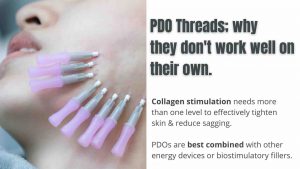

View our Treatment Gallery
What are biostimulatory Hybrid fillers & how do they work?
In 2022 Australia has the newer hybrid lasers entering the market. These dermal fillers are classed in biostimulatory-Hybrid-fillers. They differ from other fillers that add volume (think lips, cheekbones, jawline).
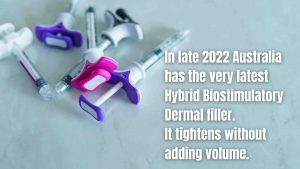
Biostimulatory fillers are designed to wake up the collagen producing cells in your dermis. With time, expect an improvement in skin laxity & turgor. Skin tightening & less wrinkles are the benefits of this class of dermal fillers. These fillers can improve laxity on the face, neck & chest areas.
A usual treatment course is two sessions of filler, spaced 4 weeks apart. For more lax skin (especially sun damage in Queensland), a third treatment is not uncommon. This filler is performed by me, or my clinical nurses at Cutis Dermatology.
Can microneedling help erase wrinkles & reduce skin laxity?
Microneedling can marginally improve fine lines & wrinkles. My team & I microneedle daily, however I employ this technique to primarily treat scars or to increase absorption of various chemicals into the deep dermal layers.

You will get more out of one laser procedure than half a dozen microneedling procedures. PRP can speed up recovery from microneedling, however it does not add to the results of any procedure except for hair restoration.
Lighting could be better, however in the after photos the better light reflex & luminosity reflects the better skin quality following treatment
.
👉The Procedure: Jessner TCA peel & low density CO2 in key vectors in addition to 60 PDO threads in vectors, RF at 3.5 mm. One session only. Predicable non-surgical skin tightening follows a complex algorithm based on clinical features, genetics, ethnicity, goals, equipment, & more
.
👍🏻The logic: Stimulation of all layers from the mid to superficial dermis (peel), deeper dermis (low density but high power CO2), hypodermis (RFM) & hypodermis & fibroseptal network (PDO threads)
.
⏭Next stage: dermal fillers to further improve the outcomes
.
🙄Suitable patients: mild to moderate laxity (leaning towards mildish). For lighter types, I prefer lasers or medium to deep peels, for darker skin types I use RF devices (RFM, NuEra, Pelleve) & HIFU
.
🎬Action: For an opinion on threads & skin tightening book a consult with Katie or Alison at Cutis Dermatology
.
😎Davin Lim
Dermatologist
Brisbane🇦🇺
AU
.
#lskintightening #HIFU #pdothreads #threadlifting #skinlaxity #brisbanedermatologist #dermatology #skinscience #facelifting #nonsurgicalfacelift #threadlift #mintpdo #mintthreads #pdothreadlifting
Skin tightening with lasers & threads🔫🧵🪡
.
👉Logic: Ablative lasers (erbium + CO2) can provide immediate collagen contraction. This can firm up skin & improve skin quality. Threads, in particular PDO threads can cause fibrosis, synergically stimulating collagen production. This can further tighten skin
.
👊🏻🤜🏻🥊Combinations: We have just started to use a combination of laser (superficial), threads (dermal-subdermal) & deeper RF timed appropriately to provide immediate, delayed & prolonged collagen production. The results, to date have been exceptional (to a point where I’m seriously surprised)
.
👍🏻Indications: mild to moderate laxity. The amount of laser vs threads vs RF & the timings varies according to age, skin quality (amount of photodamage), dermal thickness, skin type & other factors. Patient selection is critical to getting a good outcome
.
👉Next step: Adding collagen stimulating fillers in appropriate dilutions to further compound results
.
🧵Action: to see if you are a candidate for this procedure, book an appointment with the senior nurses Alison & Katie at Cutis Dermatology
.
😠BTW Cutis Derm IG page is still hacked, so don’t fall for the bitcoin sell
.
😎Davin Lim
Dermatologist
Brisbane🇦🇺
#drdavinlim #dermatologist #skintightening #PDOthreads #mintthreads
#threadlifting #threads #laserskinrejuvenation #skinrejuvenation #skinscience #brisbanedermatologist
Based upon probability and not possibility
.
👉🏾👉🏽Darker skin: more melanin, more reactive melanocytes, hence more prone to dyschromia / pigmentation. Pico lasers work well by reducing pigment and at the same time remodel collagen with little downtime (if at all). Collagen bundles are thicker and more protected from UV due to increased pigment. Collagen producing cells, or fibroblasts are larger, more numerous & more vigorous in their response to heat, hence why skin tightening devices work better in darker skin 💯
.
👉👉Lighter skin: more suitable for ablative laser, high pass fractional lasers & medium to deep peels. Darker skin type will PIH with above. Anecdotally some lighter skin types do extremely well with skin tightening devices such as #HIFU, #Ultherapy, Ultraformer, RF devices including RF Microneedling, Tempsure, Pelleve, Thermage etc… These skin types include east/mid Eurpeans, think Czech, Russian especially if photoprotected most of their lives (less collagen breakdown/elastosis)
.
😎Dr Davin Lim
Dermatologist
Brisbane,🇦🇺
.
#skintightening #skintone #antiaging #skintreatment ##ultraformer #Tempsure #thermage #davinlim #dermatologist #dermatology #collagen
Laser resurfacing can give good results. #collagen remodelling can be somewhat predictable, however the ‘lift; in this patient is quite remarkable as collagen contraction has reduced her jowls. This is an exception rather than the rule
.
.
🔬Skin Science: Ablative lasers are still relevant in #dermatology. They can be used to treat derm conditions including actinic cheilitis, sBBCs, IEC-Bowen Disease, solar keratosis, seb ks, seb hyperplasia as well as shallow acne scars. In this case I used both erbium & CO2 fully ablative lasers
.
.
👉👀Concept: Lasers can improve skin quality & provide collagen contraction. Lasers do NOT address volume. For best results it is the balance between improving skin quality, skin tightening (energy devices vs surgical), & volume replacement (filler or fat)
.
.
😎Dr Davin Lim
@drdavinlim
@cliniccutis
Brisbane🇦🇺
.
.
#laserdermatology #dermatologist #dermatologistbrisbane #skinrejuvenation #laserresurfacing #skinscience #rejuvenation #davinlim #drdavinlim #antiaging #laserrejuvenation #co2lasers #erbiumlaser
What is RF microneedling & how is it different from microneedling?
RFM or radiofrequency microneedling is vastly different from normal microneedling. To start with, microneedling pens cost between 50 to 300 dollars. A good RF microneedling device starts at $120,000 with top line RFM costing close to $150,000.
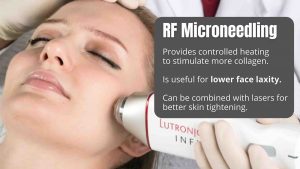
RFM provides computer controlled artificial intelligence to deliver heat to predetermined depths in the skin. Heat is required to stimulate & contract collagen, hence improving fine lines, wrinkles & skin laxity. In summary, RF microneedling-
- Treats deep dermal issues in the skin including skin laxity, thereby giving skin tightening
- Has a recovery of 2-4 days
- Requires topical numbing creams
- Can be used on all skin types
- Gives much better results than ‘cold’ microneedling
- Is often combined with lasers, peels, fillers & mono PDO threads
- Is especially effective for skin tightening of the neck & lower face
What types of chemical peels can tighten skin?
The two main groups of peels (that works) are;
AHA peels such as glycolic acid. This has no downtime, but you will require 4-6 peels for optimal results. Best for mild laxity, fine lines & wrinkles.
Jessner TCA peels can markedly improve skin laxity of the face, eyes & upper lip. Downtime ranges from 7 to 10 days. I personally perform this procedure under sedation (you not me). I usually add low dose CO2 laser to compound the results.
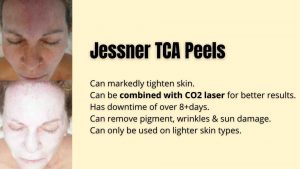
Why is it super important to tighten all layers of the skin?
This is my theory on what I call momentum neocollagenesis, which means treating skin at various depths. From the top down, this includes;
Epidermis (upper part of the skin); cytokine & growth factor release to stimulate collagen. How? Laser resurfacing, pico lasers.
Papillary dermis (one level below); stimulates elastin & collagen production.
How? Lasers & deep peels.
Reticular dermis (two levels below); as above.
How? Lasers, RF, RF microneedling HIFU, PDO threads, collagen stimulating dermal fillers.
Fat & septae (three levels below); as above.

How? HIFU, RF, RF microneedling, biostimulatory hybrid dermal fillers like Biostimulator, PDO threads.
Once the initial push is done, the momentum is then built around these layers using specific techniques that are modified according to the patient’s skin type, quality, age, expectations, & budgets.
Momentum treatments are typically performed 4-6 weeks after the initial push. Typically, slow heat RF devices are chosen, given they have no downtime. Most patients require 2-3 sessions. For patients with severe sun damage & laxity, I may perform collagen stimulating fillers at intervals of 4 weeks (2-3 in total).
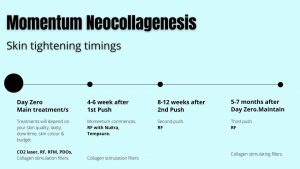
What is my best advice when it comes to budgeting for skin tightening procedures?
Most patients will have a set budget, my aim is to make sure the treatment methods you choose will give you the biggest bang for your buck.
- Don’t choose Botox* as it lasts only a few months. It doesn’t tighten, in fact it’s the opposite- it relaxes. You are much better off with dermal fillers. Performed with skill & art, they last well over 2 years, over 10 times the longevity of tox.
- Don’t spend money on skincare. Nothing in a container will lift or tighten your skin.
- Don’t spend money on LED lamps, they don’t work, but they can give you a warm & fuzzy feeling.
- Don’t just stick a sh*t load of PDOs in your face. They don’t work when performed this way.

PDOs are awesome, however used in isolation, they do very little. - Repair your skin before you try to tighten it. Lasers & deep peels can reverse sun damage. If you have broken collagen, it will not contract.
- See my nurses for treatments, they are very, very good & charge a fraction of what I charge.

The algorithm for treating neck laxity, ranging from mild to severe. Always choose a pathway that is dictated by clinical examination & not by what a clinic offers.
*This is in the context of a budget.

How long do the results last?
Most non-surgical skin tightening results last 12 months or more. You can expect longer results with lasers, chemical peels (deep), RF, & HIFU treatments combined.
Dermal fillers that stimulate your collagen production last 9-14 months. PDO threads last 6-12 months. Microcurrent may only last 2-3 days, whilst a deep plane facelift will last many decades. For non-surgical skin tightening, you can schedule annual maintenance treatments to sustain your new collagen & keep you looking its best.
How many sessions are required to improve skin laxity?
Between 2 to 6. The number of sessions is highly variable depending on your skin type, age, lifestyle, goals & expectations. With each passing session, your skin will look & feel tighter. Once we achieve the rejuvenation you’ve been looking for, you’ll be able to maintain results with occasional touch-up sessions.
* 2 sessions following treatments such as laser resurfacing, collagen stimulating dermal fillers & PDO threads.
** 3 sessions following above + RF / NuEra
***6 sessions as the company guideline for stand-alone treatments.
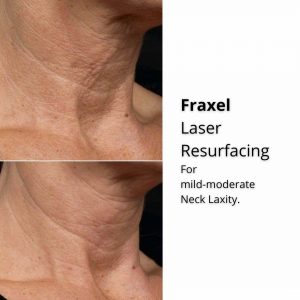
What can a plasma pen do for my skin?
Plasma pen, also known as fibroblasting is a cheap handheld device that can be purchased for about 50 dollars on eBay or AliExpress. It vaporizes tissue & is great for the treatment of viral-genital warts & skin tags.

Do not attempt to treat the face, neck, or chest. The side-effects are extraordinarily high as this procedure is not regulated.
What is LEDs phototherapy & can they work?
LLED or low-level laser emission devices are herald to treat skin, improve laxity & firmness, & reduce inflammation. We run three of these devices at Cutis Dermatology. LEDs work for skin recovery following laser or surgical procedures. They do not work as a stand-alone treatment to improve skin laxity or wrinkles.
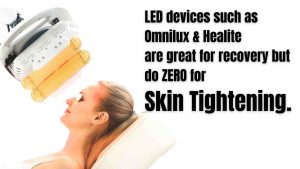
What is microcurrent & can it tighten skin & improve laxity?
Microcurrent is best for subjectively improving skin firmness, hence there is a crossover for improving skin laxity. It rarely gives an objective measurement when it comes to improving wrinkles.

Microcurrent works primarily on immediate collagen contraction. In theory it can marginally improve collagen bundles in the deeper layers of skin. My analogy of microcurrent is this-can you tell the difference in firmness of jelly when you see it? Probably not, hence you need to press. Skin turgor is the same, hence it is a subjective assessment of your own skin.

I do not have a good before & after photo, because microcurrent works on self-assessment.
Why don’t I use Thermage anymore?
It is not that it doesn’t work, it is about giving predictable skin tightening & lifting. Thermage has great success in Asia (so does HIFU). This skew in good outcomes is primarily due to a different study population. For ethnic skin, there are differences in genetics to allow for better contraction of collagen & at the same time an increase in collagen production compared to lighter skin counterparts. This is partly due to genetics (contraction) as well as pigmentation that protects the underlying skin from UVA.
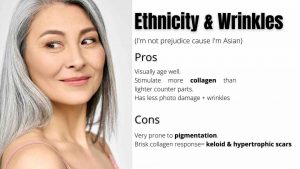
I prefer slow heating RF such as NuEra, Tempsure-Pelleve as collagen stimulation is best with momentum (read below). For fast heating devices, I use RF (much like Thermage), but delivered via microneedling, namely Infini or the updated Genius RFM. This is not only cost effective for the patient, but IMO, it gives better results than Thermage (given the population base I am treating).
What skin tightening creams are there for the face?
Even clinical creams are marginally at best. Skin care products are great for prevention, or in the case of pigmentation they are first line treatments. If you are after a good skincare routine that works, consider:
AM: Antioxidants such as ferulic, ascorbic acids & tocopherol, then SPF50+
PM: Retinol or retinoid
Every 2 weeks: AHA serum to exfoliate.
With the money you save, invest in a skin directed procedure that works.

How can I tighten my skin naturally?
Essential oils such as argan oil have been used for centuries to help tighten facial skin & reduce wrinkles. The most predictive way to tighten skin naturally is a process of fermentation of tiny little organisms known as streptococcus. These bacteria produce a sugar molecule that is called hyaluronic acid. These naturally sourced molecules are combined using high & low molecular weight HAs the packaged in sterile containers.
Your clinician can inject this naturally occurring by-product into your skin. This stimulates your body to produce collagen. Naturally.

Do collagen drinks work for skin tightening? No evidence but highly recommended if you have joint pains. Placebo can be useful. Considering how cheap they are, & if they make you feel good; knock yourself out!
When is surgery - facelift the only effective solution?
If you have moderate to severe laxity of the mid to lower face, surgery is the only effective solution. The best form of surgery is called a deep plane facelift. This is often performed at the same time as a neck lift. Short scar (mini-s) face lifts are also effective, however if you are going to do it properly, an old school plastic surgeon will give you the best results.
Remember, surgery improves skin tone (laxity), it does not address skin quality (lasers) or volume (fat, dermal fillers). For natural results, you need to address all three factors.
What are other surgical options for improving skin laxity?
We discussed face & neck lifts, other types of surgery that I perform include eyelid surgical lifting, known as blepharoplasty, as well as upper lip lift. A new automated procedure called Ellacor will be in Australia in 2023.
Ellacor is only available in the United States. This procedure is fractional removal of excess skin & tissue. This improves wrinkles, tightens skin & addresses laxity.
When do I use Ultherapy or HIFU over RF devices?
Generally, I prefer RF over HIFU (High Intensity Focused Ultrasound – Ultherapy- Ultraformer). This is why-
RF energy provides long-tail heating of collagen & the fibroseptal network (fat fibers). For patients with less facial fat, slow heating is safer. In contrast, HIFU is useful for patients with a ‘higher content’ of facial & neck fat. In this scenario, HIFU can provide slimming through collateral inflammation of fat & contraction of the fat network.
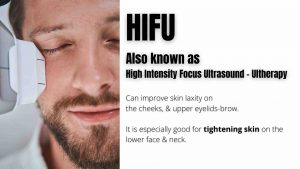
For patients with a lot of sun damage, Ultherapy & RF treatments will not work. This is because collagen & elastin is broken, a term we call elastolysis. Lasers & deep peels can repair broken collagen – solar elastosis. From there, the usual algorithm applies.

What is the fastest way to tighten skin?
The fastest way to improve facial laxity & tighten skin is to-
- Surgically excise lax skin – either punch or Ellacor, followed by resurfacing.
- Inject biostimulatory fillers a week or two later.
The rate limiting factor is how quickly your body’s immune system can remodel collagen & tighten skin.

How to prevent skin sagging so I won’t need skin tightening?
Here are two examples of programs made to prevent skin sagging, based upon skin type only.
Consider a 30–40-year-old female. Caucasian, light skin type. The yearly program goes something like this-
- Light CO2 yearly (48-hour recovery)
- RF using NuEra, Tempsure or Pelleve; 2 sessions
- Biostimulatory hybrid fillers; 1-2 sessions
- Skin care. Antioxidants, retinoids
Consider a 30–40-year-old female. Ethnic or darker light skin type. The yearly program goes something like this-
- Picosure Pro or Picoway (48 hour recovery) 2 sessions over 12 months
- RF using NuEra, Tempsure or Pelleve; 2 sessions
- Biostimulatory hybrid fillers; 1-2 sessions (optional, usually not required)
- Skin care

Timing of powerful devices such as HIFU or Ultherapy is crucial. Too early? Probably wasted your money. Too late, and it won’t work.
What is a DIY home routine to treat sagging skin & provide skin tightening?
We have discussed the role of microcurrent & the feeling of firmness. Other DIY treatments that can marginally help include non-ablative non-fractional laser resurfacing. This laser takes 3-4 minutes to perform & is FDA cleared for under eye treatments only. 40 shots under eyes in three layers performed daily for 90 days. It can be effective in patients with very thin skin & mild to moderate laxity.
LED masks? Save your money. Even clinical strength LEDs do not have the ability to lift & tighten skin.
Who’s a good candidate for skin tightening?
You’re likely to get the best results if you:
- Protect your skin from the sun
- Have mild to moderate skin laxity
- Are at a healthy & steady body weight
- Don’t smoke
- Practice a healthy lifestyle
A skin-tightening procedure may not suit your goals & expectations & hence why we are very selective on finding the correct candidate.
Davin’s viewpoint on skin tightening
Predictable skin tightening is one of the holy grails of dermatology. Very rarely is there only one treatment that can accomplish that, except for heavy laser resurfacing. When I mean heavy, that refers to a downtime of well over 10 days.
The arena of skin tightening has made enormous gains over the last decade, with newer radiofrequency devices including high powered impedance RF microneedling with sequential delivery & slow heating devices without the consumables (like Thermage). The introduction of Biostimulator to the Australian market in 2022 has also expanded the range of low downtime/no downtime procedures, whilst PDO threads have had an enormous boom, at the expense of reputation (as universal treatments for wrinkles & skin laxity). Additionally for clinics that offer one off treatment using one or two devices will invariably choose powerful devices such as Ultherapy – HIFU for patients with skin laxity & low facial volume-fat-thin-dermis. Aggressive treatments with ultrasound damages not only the patient’s facial features but also the reputation of the device.

Story time. In mid-August 2022 I was closing some big, heavy metal doors at my house. These doors are mounted on rails, & weigh well over 250 kg. The art of closing heavy sliders is to initially push (with all your might), then exert some more force (less effort than the initial push) to keep the momentum up. So, this is how I could explain my momentum neocollagenesis theory, based upon how I have approached skin tightening over the past 12 months. Can this theory be explained with scientific evidence? In parts, however controlled, randomized, assessor blinded studies are impossible (at least in Australia) to perform. This is in part to the high numbers needed to be included to make a statistical significance. Combining this with the various methods I use, based upon the patient’s facial shape, volume, downtime, expectations, budget, previous treatments & skin type would compound the complexity of any meaningful study. Add to this the inherent difference of laser & device settings, parameters, volume-depth of fillers, number of threads, peel concentration, & more the equation is almost infinite. Great for tailoring outcomes & treatments, but really crap for any statistically significant study.
Here is my theory on skin tightening, or the momentum neocollagenesis phenomena.

Observation 1. Patients with sun damage don’t contract elastin & collagen bundles well. Hence any treatments aimed at ‘tightening’ the levels without significantly changing the collagen & elastin quality is bound to fail. Said another way, if you have sun damage, you are wasting your coin on RF, & HIFU treatments. You are better off with a deep peel, CO2 laser with or without biostimulatory fillers at month 2 & 3 after ablative procedures.
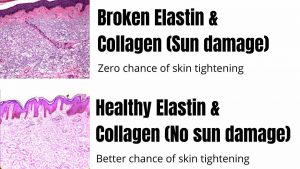
Observation 2. Patients with a thin dermis & or fat layer should not be treated aggressively with HIFU– Ultrasound or RF devices, simply because there is a lack of collagen to contract. The exception? The upper & lower eyelid skin; in the absence of sun damage. Skin tightening of the eyelids can be effective using most methods; RF, lasers, peels, Tixel & other energy devices.

Observation 3. Start off the momentum with 2 or more combinations. The combination of skin tightening methods will depend on your experience (as the provider) & the patients clinical features (plus their own ‘research’ as to what they would like; yes, medicine is now a friggin’ menu selection). The methods you can choose (excluding moderate to severe laxity when the answer is surgical) are as follows-
- Lasers: ablative works a lot better than non-ablative, however the cytokine profile of superficial lasers (think pico or 1927-1940 wavelength) can produce extraordinary outcomes when only treating 200-240+ microns.
- RF microneedling; I prefer insulation, top RFMs include Genius, Infini, & Morpheus8. You can get away with older RFMs like Intracel, Secret RF, & Intensif. You must dial in the depth based upon dermal (& subcutt) thickness. Until high resolution USS is available, you can surprisingly dial it in using your cannula to determine depth. In most cases RFM for improving skin laxity & aiding in skin tightening will require 2-4 sessions.
- Chemical Peels. Not the fairy stuff, but an acetone scrub, then modified Jessner followed by 30-35% TCA or the croton-oil-phenol peel. Peels are better if skin is fine, with pigmentation rather than etched wrinkles (phenol can work in this situation).
- Threads. As reinforced, my MO nowadays is the PDO monos. Simple, cost effective with a good life span. I did use anchoring-barbed threads in the past, but the longevity is not predictable. Additionally, I’m not into hand holding as the knots can take several weeks to months to resolve.
- Dermal fillers. I use one of three, Biostimulator, Polymer Injectable & Calcium hydroxylapatite. Providing you don’t cross the level (depth) of filler, I do combine fillers with lasers & energy devices. Energy devices do not break up HA fillers, as we proved in a study in 2017.
- HIFU, again, useful when indicated, especially for lower face fullness & laxity. In this case we are using off label & may conservatively sequentially pulse.
- RF slow heating devices reach above 115°F (46°C) for over 3 minutes, in turn causing your body to release heat-shock proteins. Examples include NuEra & Tempsure. This stimulates collagen production.

I combine threads with other treatment modalities as we need to tighten all layers of the skin. PDOs in isolation do very little.
Observation 4. Follow up the first treatment with repeated sessions 4-6 weeks after the first procedure. Create momentum. My two most useful methods are;
- Slow heating devices; NuEra, Tempsure, Pelleve.
- Dermal fillers with biostimulatory effects; Biostimulator, calcium hydroxyapatite
- For most patients I introduce these ‘pushes’ at week 4, week 8 & occasional week 12.
Once the treatment has finished (usually 3 months after starting), you only require a ‘top up’ treatment annually- usually a series of RF sessions or biostimulatory dermal fillers.
Observation 5. I was wrong about microcurrent devices. Logically how can a device, sold in shops & online deliver such a high satisfaction rate when it comes to skin tightening & reducing skin laxity? The answer lies in the subjective feeling of firmness & not the element of objective skin tightening. Microcurrent does not lift, it doesn’t remove or shallow up your nasolabial folds, but it can put you in that happy feel-good mood knowing your skin feels firmer.

Observation 6. Now this, I must admit, is a wee bit far-fetched. But I do practice it. I think skin has a specific memory & a signature that allows certain procedures to be effective. This combination is determined by genetics, race, individual & environmental factors. You are in the game of skin rejuvenation-skin tightening, with a limited number of tokens. Spend too much early on tokens that work (eg. HIFU in your 30s, or powerful RF devices), then at some point you will run out of tokens, hence you’re kind of screwed (from a rejuvenation POV). Pace yourself.
I’m so paranoid about this that I have only had one HIFU to my brows (off label, pull brow up then shoot, missing exploding my eyeball with ultrasound), that was in 2016. In 2022 I had ONE RF session with NuEra. The complexities of facial & neck skin tightening have been illustrated with this write up. I still think we will improve non-surgical methodologies in the next two decades with the introduction of micro-coring devices, new energy devices, lasers & of course dermal fillers.
The limitation is not technology, but will be the regeneration capacity of humans…



